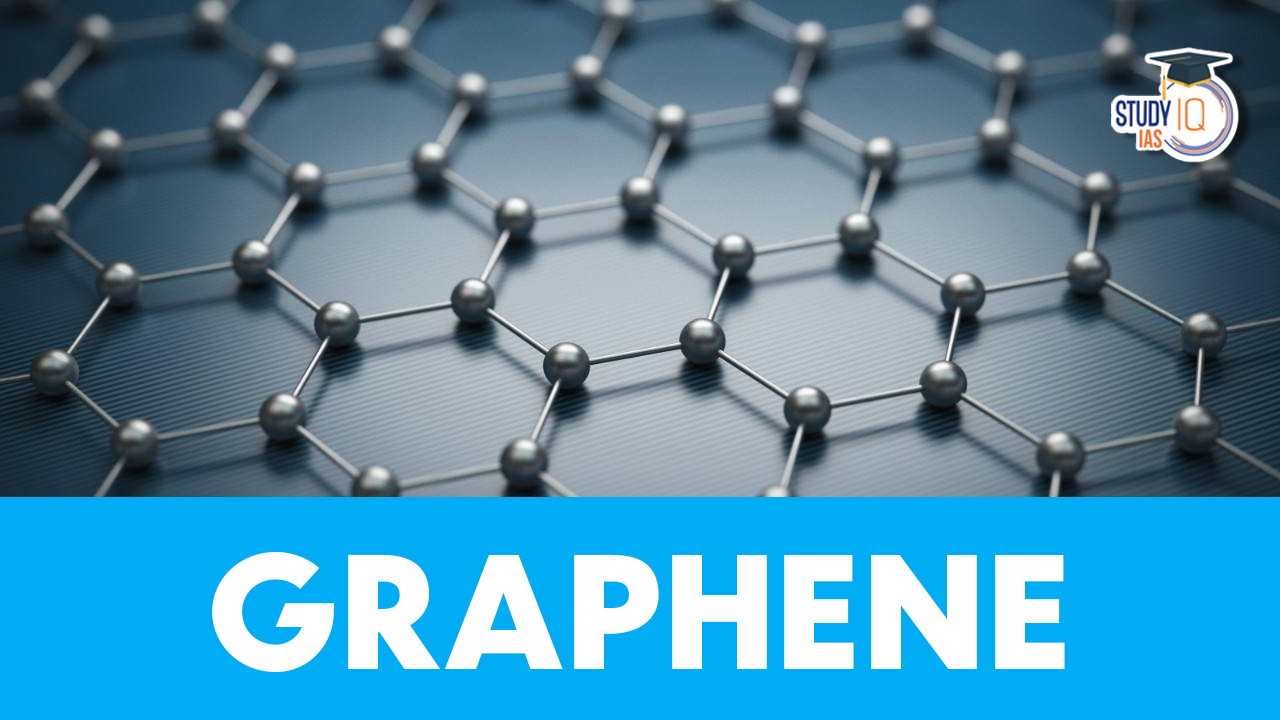Table of Contents
Context: Graphene along with Artificial Intelligence and Quantum Computing will be one among the emerging technologies that will disrupt the existing human-machine interface.
What is Grapheme?
- Graphene is an allotrope of carbon, made up of a single layer of atoms (1 atom thick) arranged in a hexagonal lattice nanostructure.
- It is the world’s thinnest, strongest, and most conductive material of both electricity and heat.
- Features of graphene:
- Electric and heat conductivity: Graphene’s electricity conducting capacity is better than copper.
- Strength: Graphene is about 200 times stronger than steel but six times lighter.
- Light absorption: Graphene absorbs only 2% of light and is almost perfectly transparent.
- Permeability: Graphene does not allow gases to pass through, even those as light as hydrogen and helium.
- Composite structures: Graphene added in small quantities can produce composite materials with dramatically transformed qualities.

Applications of Graphene
| Electric equipments |
|
| Electronic sensors |
|
| Health and protection |
|
| Defence technology |
|
| Sports and aerospace equipment |
|
Global status of Graphene
- Even though graphene was discovered in 2004, producing high-grade large-scale graphene was possible recently.
- As per latest reports, at least one graphene-enhanced product was launched every week in 2022. More than 300 companies are engaged in producing graphene or its derivatives.
- The global graphene market value is estimated at $175.9 million in 2022 and is expected to grow at a CAGR of 46.6% between 2023 and 2030.
- Leading researchers: China, the U.S., the U.K., Japan, South Korea, Russia, and Singapore are the leading researchers of graphene.
- Patents: Till 2012, US dominated graphene-related patent filing. South Korea and China caught up with US between 2013 and 2016.
- After 2017, China has dominated. It has filed 218 patents while the other leading countries together filed 79. India has eight filings.
- Commercial production: China and Brazil are global leaders in the commercial production of industry-grade graphene.
Graphene and India
- Government institutions: The Centre for Nano Science and Engineering at IISc Bangalore along with KAS Tech produced a graphene-based system some years ago.
- IIT Roorkee-incubated Log 9 has patented a technology for graphene-based ultra-capacitors.
- IIT Kanpur-incubated RF Nanocomposites has developed EMI shielding and stealth technology using graphene-based nanotubes.
- The government has set up India Innovation Centre for Graphene in Kerala for research in graphene.
- Private sector: Tata Steel has successfully grown graphene (about 50 micrometers large domains) using annealing and extracting atomic carbon from steel surface. It has succeeded in mixing graphene with used plastic products to recycle them as new.
Way forward
- Producing high quality graphene is extremely challenging, requiring high expertise and technological capabilities.
- Countries across the world have succeeded in making big strides in graphene production due to government initiatives.
- China declared graphene a priority in its 13th Plan. Europe set up the Graphene Flagship in 2013 with a budget of €1 billion.
- For India to replicate such success there needs to be a national mission on graphene. A nodal Ministry needs to be entrusted with this responsibility for proper implementation.
- Due to high cost-to-volume ratio for high-grade graphene, its production may get concentrated in a few locations in the world and India needs to ensure it does not miss this opportunity.
Other Allotropes of Carbon
- Diamond: Diamond is the hardest known natural mineral and is made up of face-centred cubic lattice. It is formed under high pressure and temperature.
- Fullerene: Fullerene consists of carbon atoms that are connected by single and double bonds to form a round cage-like structure.
- Graphite: It is a crystalline form of carbon that is made up of stacked layers of graphene. It is the most stable form of carbon under standard conditions.
- Carbon nano-tubes: They are cylindrical molecules that consist of rolled-up sheets of single-layer carbon atoms (graphene).



 Bharat Bandh 9 July 2025: Over 25 Crore ...
Bharat Bandh 9 July 2025: Over 25 Crore ...
 UPPSC Mains Question Paper 2025: Downloa...
UPPSC Mains Question Paper 2025: Downloa...
 Sukhoi Su-57: Will India Choose Russia�...
Sukhoi Su-57: Will India Choose Russia�...





















